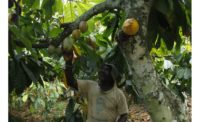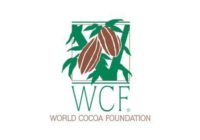
|
| A child works in a cocoa field. Photo provided by the International Labor Rights Forum. |
As the holiday chocolate buying season moves into high gear in the United States, a new report from the International Labor Rights Forum (ILRF) out today sheds light on the struggle of West African cocoa farmers to earn decent livelihoods — despite increasing demand for cocoa and higher prices.
About 60 percent of the world’s cocoa comes from Ghana and Côte d’Ivoire. And, the report, The Fairness Gap: Farmer Income and Root Cause Solutions to Ending Child Labor in the Cocoa Industry, shows that the poverty endured by West African farming communities continues to undermine efforts to end child labor and trafficking and advance sustainable cocoa farming.
Among other findings, the report notes that chocolate supplier and manufacturer efforts to improve working conditions, schools and supply certification, are getting mixed reviews due to a failure to address the underlying poverty problem in Ghana and Côte d’Ivoire.
The information in the report is based upon field research conducted by the International Labor Rights Forum in Ghana and Côte d’Ivoire. The report documents the economic drivers of poverty among cocoa farmers in these two West African nations, and outlines recommendations for empowering farmers in their global supply chain.
“Increasing consumer demand for chocolate made without child labor has pushed more and more companies over the past few years to confront their supply chains to understand where their cocoa actually comes from,” says Elizabeth O’Connell, fair labor campaigns director at Green America. “The best way for a company to ensure fair treatment of the farmers who grow its cocoa is to establish long-term and direct relationships with its farmers, and ensure a sustainable price is paid, one that covers all inputs including fertilizers and labor.”
Other key report findings include:
- $2 a day: Many cocoa farming families in Ghana and Côte d’Ivoire make around the international poverty line of $2 per day, but with large families, this amounts to roughly 40 cents per person.
- Child labor and casual workers: Low earnings make it difficult for farmers to pay hired laborers to harvest the crop at the legally required minimum wage, fueling the need for child labor and, especially in Côte d’Ivoire, the trafficking of casual workers (including children) from neighboring Mali and Burkina Faso.
- Farmer isolation: The majority of cocoa farmers are isolated geographically and must rely on a vast network of middlemen to transport their beans. Farmers also lack price information and negotiating power.
- Farmer age increasing: The average age of cocoa farmers is increasing as younger people seek alternative means of income. This also increases the need for casual workers, who are even more marginalized.
"When I talked with cocoa farmers in Côte d'Ivoire, what struck me most was that western companies and NGOs had been talking to them for years about child labor and how to increase their yield, but none of them felt they had been consulted about what would actually help lift them out of poverty," says Judy Gearhart, executive director of the International Labor Rights Forum.
Gearhart says the cocoa farmers are at such a disadvantage in the global marketplace.
“Millions of cocoa farmers with only a handful of global buyers leads to a system in which farmers are voiceless, lacking access to information, and unable to negotiate for a better price,” she explains. “To fix the problems, we must focus on solutions that empower farmers so they can earn their fair share from this incredibly profitable industry."
The report was released today during a roundtable discussion in Washington, D.C., which explored how to eliminate child labor and other human rights abuses in the cocoa sector by addressing poverty among vulnerable farmers in Ghana and Côte d’Ivoire.
The panel and report are part of long-standing efforts by ILRF and Green America to ensure chocolate companies are held accountable for child labor issues further down in their supply chains.





